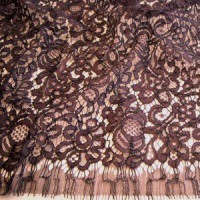For a long time, laces have been utilized for decorating, both homes and clothes. Actually, manufacturing lace is an important section of the industry of narrow fabrics. They decorate clothing and are also utilized to raise the loveliness of home furnishings like bed linen, curtains and table cloths.
An extremely delicate and beautiful piece of lace adds great beauty and worth to an otherwise plain garment. The holes in lace which consist of different designs emphasize the lace’s attractiveness. This exceptional feature of lace differentiates it from other materials.
Genuine lace is believed to have initially been produced in the late 15th or early 16th century. The most wonderful laces were created in France, Italy and Belgium. A wide range of lace varieties were produced also in numerous parts of China, Europe, Philippines, India as well as Central and South America. In Denmark, lace is known as blonder.
Various Methods of Utilizing Lace to Decorate
Some methods of using lace are ancient while others are very new and unique:
- Lace can be utilized as a foundation fabric for making costumes and lingerie.
- They can be utilized as trimming or decoration of dresses particularly for children’s clothes.
- They make wedding gowns look elegant and graceful. Actually, gowns like these do not look complete without a bit of lace to decorate them.
- It is advisable to harmonize laces with materials’ texture and color. If it is hard to get lace of specific color, it is possible to dye them as they are easy to dye.
- Black lace on black satin, or silver lace and white combined with white, light colored or silver fabrics look stunning.
- A lace shawl looks great with gowns, particularly wedding gowns.
- For a feeling of loyalty, use lace to decorate handkerchiefs.
Lace Business in Denmark
The word lace reminds Danes of Tonder. When you pay a visit to the Drohses House Museum, a world of exceptional lace is presented. Different from other states, Denmark has limited popular local products. However, lace is exceptional.
Tonder became the main hub of lace production as the town bordered on Germany and Denmark and the industry for lace originated from the south in mid 1600s. The immense lace traders resided in the town. They offered employment to a workforce numbering hundred or even thousands of peasant women and girls from the area nearby.
The women needed to pay for their personal equipment while the traders offered them thread and patterns they required to utilize. The traders offered them the thread and patterns they needed to utilize. The fine lace exudes elegance and uniqueness.
-
Kinds of Lace
- Alencon lace consists of a superior net ground as well as an improved exterior border. Nowadays, most of this kind of lace is made by machine. In general, it is utilized as decoration for wedding gowns.
- Chantilly lace is a kind of bobbin lace. Initially, it was produced in Chantilly, France. It was embraced well in the 17th century. It is styled using delicate flowers, branches, scrolls and lovely net ground. The design is mainly outlined using silk thread which is heavy. It is normally utilized in wedding gowns.
- Battenberg lace, known popularly as Renaissance lace, is manufactured by utilizing loops of woven tape joined together using yarn brides to create patterns. It is currently created by machine and is mainly utilized in bridal attire and tablecloths.
